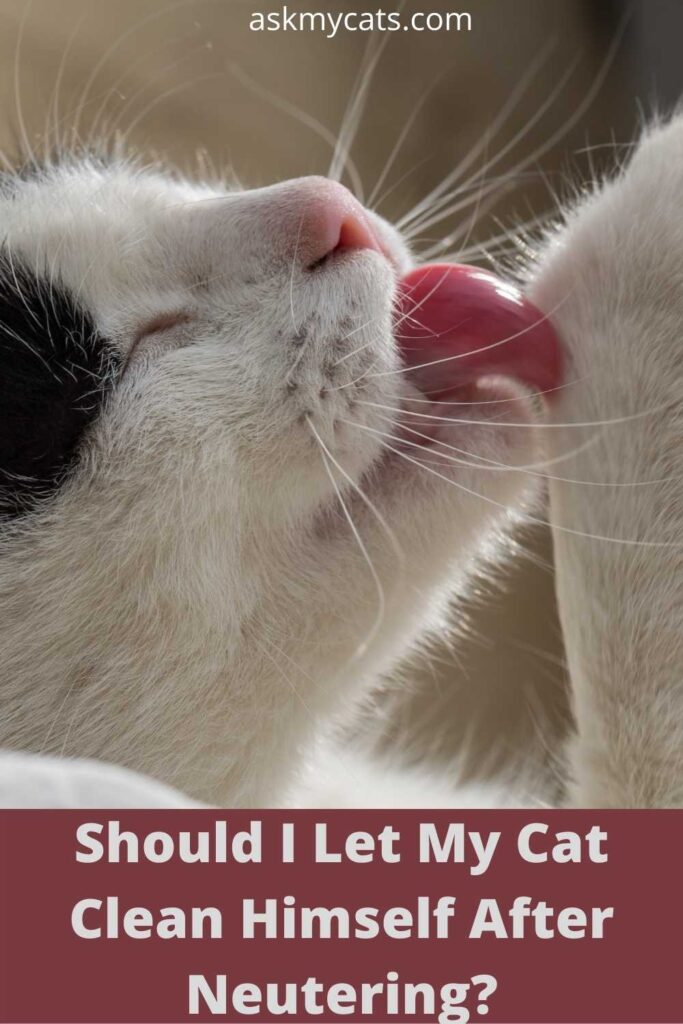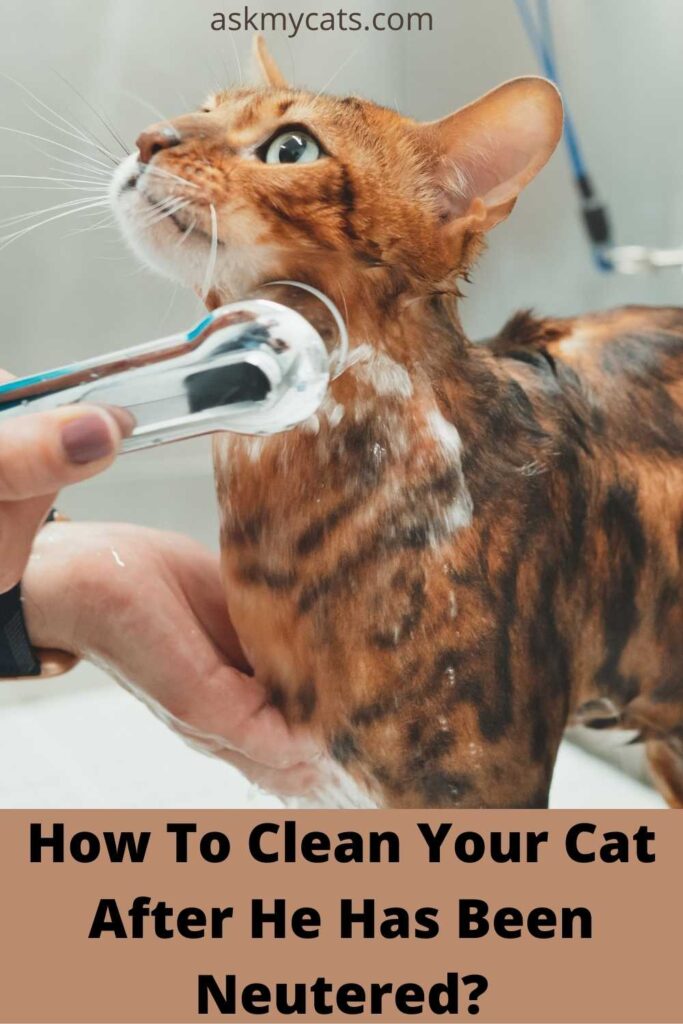As a cat owner, I am aware that after the spaying/neutering procedure, many questions enter your mind. You probably have no idea, which is why you came here looking for an answer.
First of all, by having your cat neutered (or spayed), you thankfully avoided the birth of an unwanted litter of kittens, which was a really excellent thing to do. There are already too many cats in the world, but no one cares for them.
You are responsible for your cat’s post-spay care as the cat owner. This entails controlling your cat for a few days and carefully watching her incision.
In this article, we’ll cover everything from whether it’s alright to bathe your cat right after surgery to how to take care of them if it isn’t.
Let’s get into it.


Give Your Cat the Perfect Day
Get the Free Ebook!
Can You Give Your Cat A Bath After His Neutering Surgery?

No, you cannot bathe your cat just after he has been neutered.
Owners, though, are not necessarily ecstatic about the possibility. Your cat won’t be fully itself for 24 to 48 hours following surgery. They might not keep the same level of cleanliness, as usual, making you desire to bathe them.
After neuter or spaying, you cannot bathe your cat since the incision site needs to remain dry. Due to their dislike of baths in the first place, the majority of cats are perfectly content with this arrangement.
Here are the reasons why you shouldn’t bathe them immediately:
1. Risk Of Infection
The risk of infection is the major justification for not bathing your cat after surgery.
The conventional wisdom was that keeping the incision site moist prior to the removal of the stitches would increase the chance of infection.
However, more recent research has contradicted this.
Most doctors now recommend waiting 48 hours following surgery before taking a bath.
Your cat probably cares the least about it but it is, however, a piece of important information for you to know. It’s recommended to follow your veterinarian’s instructions until more research on cats is done so that your cat can live healthily without complications.
2. Dissolvable Sutures
These days, a lot of veterinarians favor dissolvable sutures. Sutures and stitches don’t require a second visit to be removed; instead, they fall out naturally with time.
Dissolvable sutures can be removed without the need for suture removal, so you can still bring your cat in to make sure they are healing properly.
You and your cat may find life a little easier as a result. Water, on the other hand, may have an impact on some varieties of dissolvable sutures, causing them to disintegrate earlier than expected.
[Important Note]
You might not be able to see any stitches or sutures on your cat, depending on how the incision site was closed. You might be a little perplexed by this.
After all, how would you know when to bathe them if they aren’t supposed to be till the sutures are taken out? Can you give them a wash right away if there aren’t any stitches?
Some veterinarians use dissolvable or ordinary sutures to seal the external wound. However, a lot of veterinarians now close this with surgical adhesive.
You should treat the incision as you would one with visible stitches because stitches or sutures are frequently still used on the inside.
Must Read: Why Is My Spayed Cat Pulling Out Her Stitches?
Should I Let My Cat Clean Himself After Neutering?

Cats clean themselves and maintain hygiene by licking.
After he is neutered, cat owners must NOT allow their cats to lick themselves.
To avoid self-harm and infections caused by licking the incision site, you should give your cat an e-collar.
Notice: Knowing the symptoms of an illness is essential for bringing your cat back to the vet for the right care.
These symptoms include bruising, increased redness, an open incision, a foul odor, excessive swelling, fluid discharge, or a hot-to-the-touch incision site.
Bring your cat to the veterinarian right away if it exhibits any of those symptoms in addition to being lethargic so that the doctor can determine the cause and offer the appropriate treatment.
To avoid infections, make sure to adhere to the aftercare recommendations that your veterinarian has provided.
Healing Site
A neuter incision that is healing should look pink and have minimal to no swelling. Additionally, the incision shouldn’t release anything other than a tiny amount of clear fluid with a bloody tint on the first day.
Contact your vet straight away to schedule a check-up if you have any worries about your cat’s health or if something does not seem right with the incisions.
Interesting Read: Can I Bathe My Cat In Winter?
When Can I Bathe My Cat After Neutering?
You are strictly not allowed to bathe your cat within 48 hours of his surgery, Give him at least a few days before you can reintroduce him back to the water for a shower.
After surgery, you must wait 10 to 14 days before giving your cat a bath. As a result, the wound has time to heal fully.
Interesting Read: How Long Should A Cat Wear A Cone After Being Neutered?
How To Clean Your Cat After He Has Been Neutered?

You can clean your cat post-operation in the following ways:
1. Use Bath Wipes:
One way to clean your cat without submerging them in water is to use bath wipes. Make sure you buy pet-specific wipes. Your cat should not use wet wipes made for people. A cat’s skin has a very different pH than ours.
It is preferable to avoid applying the wipes to the incision site immediately. When necessary, they can be applied to your cat’s entire body.
2. Using Dry Shampoo:
Another choice for keeping your cat clean is dry shampoo. The majority are foam-like. Simply saturate your cat’s fur with the foam. For optimal results, you might want to brush the fur after it has dried.
Rinse is not necessary. These items are made to remain on your cat’s fur. They provide conditioning in addition to cleansing.
Applying dry shampoo near the incision site is not advised. Apply it to the rest of their body instead.
3. Use A Sponge Bath:
You might want a more intensive cleaning than wet wipes or dry shampoo can offer. You might give them a sponge bath in this situation. It is not advised to take a sponge bath unless it is absolutely necessary.
Wet wipes or dry shampoo will typically do a good job of cleaning your cat.
How- You’ll need a tub or pan of warm water, a sponge or rag, and cat shampoo to give your cat a sponge bath.
Allow the cat to lie down on the towel that you have placed on your lap. So that it is not exposed to water, their stomach and the place of their incision should be on the towel.
After wetting the sponge, start rubbing it across your cat’s fur. It should start to get damp but not too wet. Use a little cat-safe shampoo on your hair. The best option is a smaller sum. Rinse your hair after lathering up the shampoo.
Start by wetting the sponge and rubbing it over your cat’s fur. When necessary, rinse the sponge in water.
Find out the reasons for Cat Lathergic After Spay
How Do I Clean My Cat’s Neuter Incision?
First, be very gentle and use a clean towel or gauze that has been mildly moistened with warm water if you notice a clean discharge coming from the area of your cat’s wound.
Alcohol and hydrogen peroxide should NOT be used unless specifically recommended by your veterinarian since they can be an uncomfortable and slow recovery.
Don’t worry about how long your cat’s incision is. A two-inch and a four-inch incision will heal in the same length of time as long as other circumstances stay the same since incisions heal from side to side rather than from end to end across the gap.
In comparison to a minor wound that is left exposed, a long incision that has been properly closed and the edges kept close together will heal more quickly.
Interesting Read: How To Keep Your Cat From Jumping After Surgery?
Frequently Asked Questions
How to stop my neutered cat from licking his incision site?
Your cat is more likely to become infected if he licks himself following the treatment. Wearing an e-collar is the best approach to prevent your cat from licking the area around its incision.
Your cat won’t be able to lick the incision site while wearing an e-collar, reducing the risk of infection. Additionally, e-collars will reduce the chance of the incision being torn open.
You can get one on your own if the vet does not give it to you. Your cat will find it difficult to lick the area as a result. Your cat should wear the collar for 5-7 days in the ideal scenario.
Final Words
That’s all about neutered cats and the aftercare of their incision sites.
Let us know in the comment section when you got your cat neutered. How did you handle the post-operative situation?
Must Read: Cat Died After Bath: Know the Possible Reasons
Interesting Read: How To Neuter A Cat At Home With A Rubber Band?
